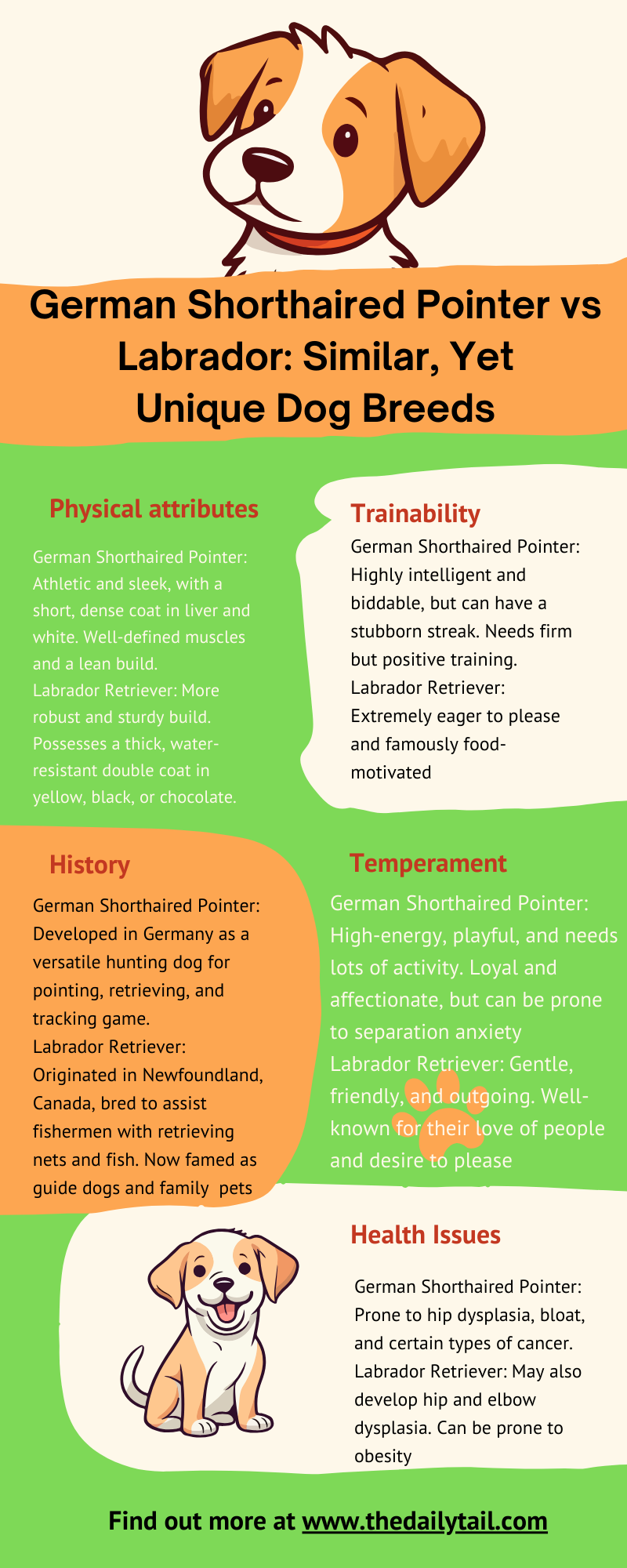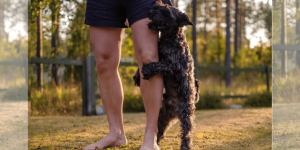So, you’re thinking about a GSP or a Lab? Excellent choices… but let’s be honest, they couldn’t be more different! With years of dog ownership behind me, I’m here to help you figure out which breed’s personality truly matches your lifestyle.
Selecting the right dog breed requires careful consideration of one’s lifestyle, family, and activities. The German Shorthaired Pointer and the Labrador Retriever are two popular breeds that share similarities in their friendliness and suitability for families but differ in their origins, energy levels, and traditional roles. Both breeds are known for their intelligence and versatility as well as their capability to form strong bonds with their owners. Let’s delve into the German Shorthaired Pointer vs Labrador breed comparison.
The German Shorthaired Pointer is a breed that originates from Germany, bred for its proficiency in hunting thanks to its agility and keen senses. This breed is distinguished by its sleek, short coat and an athletic build that suits an active outdoor lifestyle. The Labrador Retriever, on the other hand, is revered for its gentle nature and trainability which stems from its origin as a fisherman’s helper in retrieving nets and fish, evolving into a beloved family pet and versatile working dog.
When comparing the two, prospective owners should consider the specific traits of each breed. The German Shorthaired Pointer typically displays a higher energy level, requiring plenty of exercise to stay physically and mentally stimulated. Labrador Retrievers are also active and enjoy exercise, but they tend to adapt more readily to various levels of household activity.
Both are approximately 21 to 25 inches tall, and their amiability makes them good choices for both experienced and novice dog owners. They are also known for being very friendly with children, which makes them excellent additions to family homes.
Breed Origins and History
The distinct histories of the German Shorthaired Pointer and the Labrador Retriever reflect their development into the versatile and beloved breeds they are today. While the German Shorthaired Pointer has its roots in 19th-century Germany, the Labrador Retriever comes from a lineage that traces back to 19th-century England and Canada.
German Shorthaired Pointer Origins
The German Shorthaired Pointer (GSP), with its origins in Germany, was developed in the 19th century by crossing various pointing breeds, such as the Spanish Pointer, English Pointer, and possibly other breeds like the Foxhound. The breeders’ aim was to produce a versatile hunting dog adept at pointing, retrieving, and tracking game across diverse terrains.
- Country: Germany
- Development Period: 19th Century
- Breed Influences: Spanish Pointer, English Pointer, others (possible)
Labrador Retriever Origins
Labrador Retrievers originated from dogs brought to Newfoundland, now part of Canada, by English settlers. The breed’s ancestors were known as St. John’s dogs and were revered for their expertise in retrieving fish and game. Labradors were refined in England in the 19th century, where they gained their reputation as excellent gun dogs.
- Countries: England, Canada
- Development Period: 19th Century
- Early Name: St. John’s dogs
- Refinement: English breeding led to the breed’s recognition and reputation as skilled retrievers.
Appearance and Physical Traits
When comparing the German Shorthaired Pointer and the Labrador Retriever dog breed, distinct differences are evident in their size, coat, and physical features. These breeds possess unique traits making them easily distinguishable from one another.
Size and Weight
German Shorthaired Pointer:
- Height: Around 23 to 25 inches at the shoulder for males, and 21 to 23 inches for females
- Weight: Typically weighs between 55 to 70 pounds for males, and 45 to 60 pounds for females
Labrador Retriever:
- Height: Males stand about 22.5 to 24.5 inches, while females range from 21.5 to 23.5 inches
- Weight: Males weigh between 65 to 80 pounds, and females are usually 55 to 70 pounds
Coat and Shedding
As someone who’s spent a lifetime cleaning dog hair off everything, let me tell you: choosing between a German Shorthaired Pointer and a Labrador Retriever isn’t just about personalities. It’s about finding the right type of shedding for your sanity!
German Shorthaired Pointer:
- Coat: A short, thick, water-repellent coat
- Shedding: Sheds moderately, but regular grooming can help manage this
Labrador Retriever:
- Coat: Sports a dense, double coat that’s also waterproof.
- Shedding: Sheds throughout the year heavily, with seasonal peaks.
Distinctive Features
German Shorthaired Pointer:
- A lean, athletic build with a graceful outline and docked tail, characterized by its versatile hunting skills
- A broad, clean-cut head with keen, intelligent eyes
Labrador Retriever:
- A sturdy, solid build well-suited to active work, with a wide head, broad features, and an iconic “otter” tail
- Friendly eyes express character and intelligence
Temperament and Behavior
When examining the temperament and behavior of the German Shorthaired Pointer and the Labrador Retriever, one finds both breeds exhibit high levels of intelligence and affection, fitting well within family dynamics and showing friendliness towards children.
About German Shorthaired Pointer
The German Shorthaired Pointer is known for its energetic and intelligent nature, making it a highly trainable breed. They display a deep affection for their family, with a personality that is both playful and loyal. Their energy levels are quite high; thus, they require regular, vigorous exercise to maintain physical and mental health. Their temperament is generally even-tempered and kid-friendly, providing they are given proper socialization from a young age.
About Labrador Retriever
Labrador Retrievers are renowned for their friendly and affectionate demeanor. As a breed, they are extremely loving and gentle, often considered the quintessential family dog. Additionally, Labradors are noted for their intelligence and loyal personalities. They have high energy levels, demanding regular play and exercise, but are typically less intense than German Shorthaired Pointers. Labradors are known to be patient and good-natured with children, making them an ideal choice for a family pet.
Children and Family Integration
Both German Shorthaired Pointers and Labrador Retrievers integrate well into family settings. German Shorthaired Pointers, being playful and energetic, tend to match well with active families and older children who can engage with them in physical activities. Labrador Retrievers, with their gentle and patient nature, are suited to families with children of all ages and are often more adaptable to various levels of household activity. Their affectionate nature makes them a comforting presence within the home.
Exercise and Training Requirements
When comparing the German Shorthaired Pointer (GSP) and the Labrador Retriever, one must consider how their exercise and training requirements align with an owner’s lifestyle. Both breeds are active and intelligent, necessitating consistent training and adequate physical activity.
Energy Level and Exercise Needs
German Shorthaired Pointer:
- Energy Level: High; they require rigorous daily exercise
- Exercise Needs: A minimum of 1-2 hours per day of vigorous activities such as running, swimming, or agility training
Labrador Retriever:
- Energy Level: Also high, but may be slightly less intense than the GSP
- Exercise Needs: At least 1 hour of robust exercise daily with a preference for retrieving games and swimming
Both breeds have a strong prey drive and appreciate activities that cater to their instinctual behaviors. They need regular mental stimulation to prevent them from becoming bored, which can lead to destructive behaviors or excessive barking.
Trainability and Intelligence
German Shorthaired Pointer:
- Trainability: Highly trainable, with a responsive attitude towards obedience training
- Intelligence: They excel in various canine sports and are quick to learn new commands but require firm and consistent training methods due to their strong will
Labrador Retriever:
- Trainability: Known for their obedience and ease of training; one of the easiest breeds to train
- Intelligence: Labs are incredibly intelligent and often used as service dogs because of their responsive and eager-to-please nature
For both the GSP and Labrador Retriever, early socialization and training are crucial. They respond well to positive reinforcement techniques, and their intelligence makes them suitable for various roles in work and companionship. Neither breed typically has high grooming needs, but regular exercise is paramount to keep them healthy and content.
Health and Lifespan
When considering the German Shorthaired Pointer and the Labrador Retriever, prospective owners should be aware of each breed’s health issues and expected lifespan. Understanding these factors can help in providing the right care and attention needed for a healthy life.
Breed Common Health Issues
- German Shorthaired Pointers may not commonly suffer from acute moist dermatitis, hip dysplasia, or bloat, but they are still at risk for other health problems like epilepsy and osteochondrosis dissecans.
Health Issue German Shorthaired Pointer Labrador Retriever Hip Dysplasia Less Common Common Bloat Less Common Common Ear Infections Common Common Cataracts Less Common Common Acute Moist Dermatitis No Yes Cold Tail Uncommon Common Elbow Dysplasia Uncommon Common Epilepsy Possible Less Common Myopathy Uncommon Common Osteochondrosis Dissecans Possible Less Common Progressive Retinal Atrophy Uncommon Common Tricuspid Valve Dysplasia Uncommon Less Common - Labrador Retrievers are prone to a range of health issues such as hip dysplasia, elbow dysplasia, and bloat. They also have a propensity for progressive retinal atrophy and myopathy, in addition to ear infections which they share with the German Shorthaired Pointer.
Maintenance and Lifespan
- Lifespan
- German Shorthaired Pointer: Typically, they have a lifespan of 12 to 14 years
- Labrador Retriever: Generally, their lifespan ranges from 10 to 12 years
- Maintenance
- Diet: Both breeds require a high-quality diet tailored to their age, size, and activity level. Obesity can be a concern, especially for Labradors, and therefore proper diet management is key
- Exercise: They both need regular exercise to maintain health. German Shorthaired Pointers may require more vigorous activity due to their high energy levels
- Healthcare: Regular vet check-ups and preventive measures like vaccinations and parasite control are crucial for both breeds. Special attention should be paid to their ears to prevent infections, and Labs should be monitored for signs of joint problems, like hip and elbow dysplasia
A thorough understanding of and attention to these health concerns and maintenance requirements can contribute to a longer, healthier life for these breeds.
Living Environment and Adaptability
Both the German Shorthaired Pointer and the Labrador Retriever have adaptable natures but differ in their living environment needs due to varying energy levels and space requirements.
Housing Needs
The German Shorthaired Pointer, with a high energy level, thrives in a home with plenty of space to move and a secured backyard where they can play and exercise. They are less suited for an apartment life due to their need for physical activity. In contrast, the Labrador Retriever can adapt to apartment living provided they receive adequate exercise. However, they also benefit from a home with space where they can stretch out and play.
- German Shorthaired Pointer: Needs ample outdoor space, prefers houses
- Labrador Retriever: More flexible, adapts to apartments if well-exercised
Adaptability to Different Lifestyles
Adaptability is a strong suit in both breeds; they adjust well to various lifestyles as long as their basic needs are met. The German Shorthaired Pointer is an ideal companion for an active lifestyle and enjoys being involved in family activities. They may not suit a sedentary lifestyle due to their high energy. Labradors are famously adaptable, their good-nature allows them to fit into various households – from active outdoor enthusiasts to more relaxed environments, as long as they receive attention and regular exercise.
- German Shorthaired Pointer: Best with active families, not suited for inactivity
- Labrador Retriever: Versatile, fits well with most family dynamics
Breed-Specific Considerations
When selecting a dog breed, potential dog owners must consider each breed’s unique abilities, especially regarding hunting and retrieving as well as their compatibility with other pets. These factors are particularly pertinent for the German Shorthaired Pointers vs Labrador Retriever dog breed comparison.
Hunting and Retrieving Abilities
German Shorthaired Pointers (GSPs) are renowned for their athleticism and versatile hunting skills. They are adept in various terrains, both on land and in water, and excel in tracking, pointing, and retrieving. GSPs are often selected by hunters for their keen sense of smell and high energy levels.
- Primary Uses:
- Tracking
- Pointing
- Retrieving game
On the other hand, Labrador Retrievers have an innate proficiency for retrieving, particularly from water due to their water-resistant coat and otter-like tail. They are historically bred for retrieving waterfowl and have a soft mouth grip, which enables them to retrieve game without causing damage.
- Primary Uses:
- Waterfowl retrieving
- Gentle game handling
Compatibility with Other Pets
German Shorthaired Pointers are sociable and generally integrate well with other pets if properly socialized from a young age. They may have a higher prey drive due to their hunting heritage, which necessitates careful introduction and consistent training.
Interaction with Other Pets:
- Requires early socialization
- May exhibit prey drive
Labrador Retrievers are characteristically friendly and amiable, often displaying an excellent temperament around other pets. Their agreeable nature typically makes them companionable housemates for other pet species.
Interaction with Other Pets:
- Typically good with other pets
- Known for their friendly disposition
Comparison Summary and Final Thoughts
Let’s finish off with the main aspects contrasting the German Shorthaired Pointer and the Labrador Retriever, guiding prospective owners in making an informed decision.
Key Differences
German Shorthaired Pointer
- Exercise Needs: They require extensive exercise and are suited for active families
- Temperament: They exhibit a high level of intelligence with a penchant for curiosity
Labrador Retriever
- Family Integration: Known for their exceptional friendliness, they are exceedingly pet and stranger-friendly
- Adaptability: Labs often display a high degree of versatility, able to thrive in various living conditions
These breeds, while sharing similarities such as intelligence and friendliness, show distinct differences. The German Shorthaired Pointer is more high-energy and requires an environment that can cater to their exercise needs. In contrast, Labrador Retrievers are more universally adaptable and may be a better fit for families with children or other pets.
Choosing the Right Breed for You
When selecting between these breeds, consider the following:
- Activity Level: Ensure your lifestyle can accommodate the German Shorthaired Pointer’s need for physical activity or the Labrador’s versatility
- Family Dynamics: Labradors typically integrate well into family settings and are amiable with strangers, whereas German Shorthaired Pointers may require careful introduction and socialization
- Purpose: If seeking a breed with a slight edge in athleticism for activities like hunting, a German Shorthaired Pointer might be preferable
The choice between a German Shorthaired Pointer and a Labrador Retriever hinges on aligning their characteristics with your living situation, family makeup, and activity level. Each breed offers a unique set of qualities that, when matched with the right owner, can lead to a rewarding companionship.










